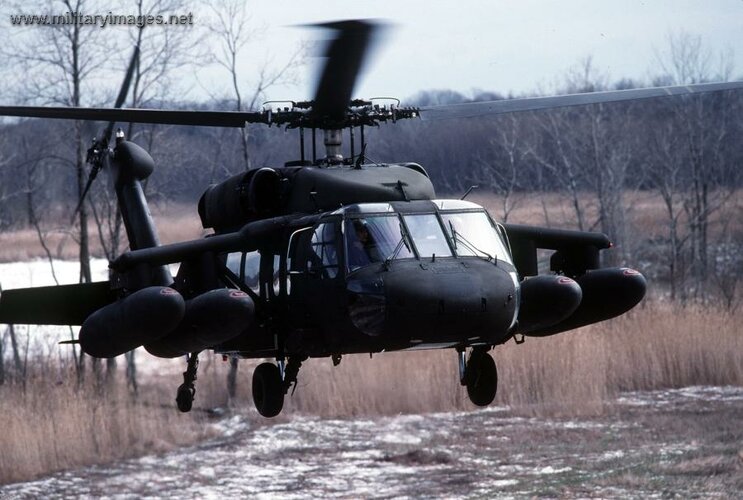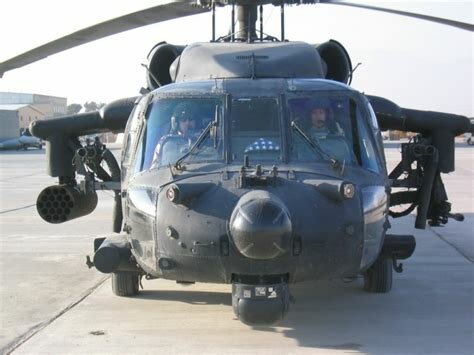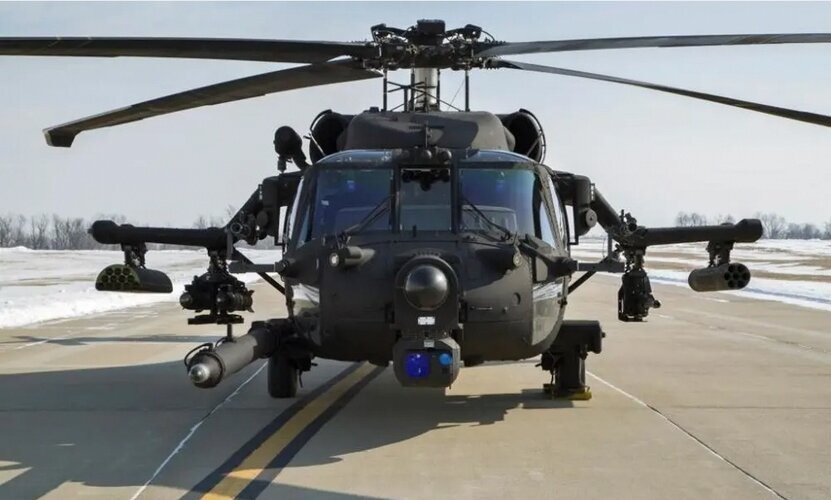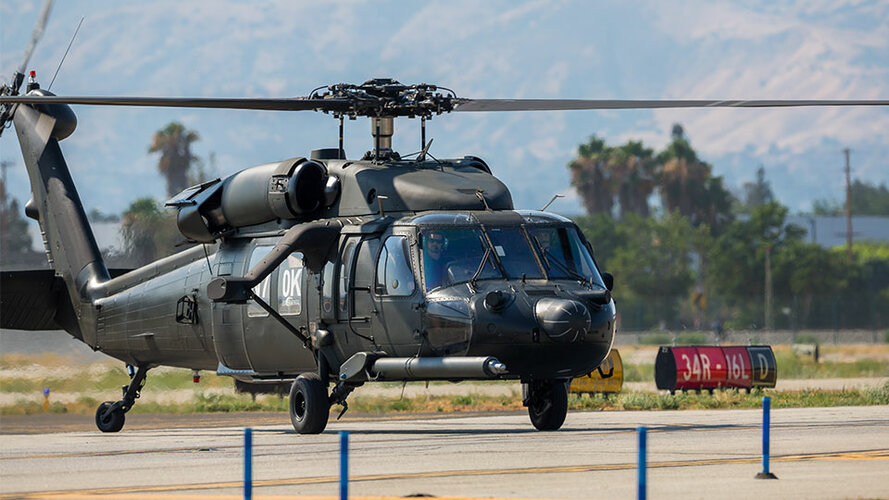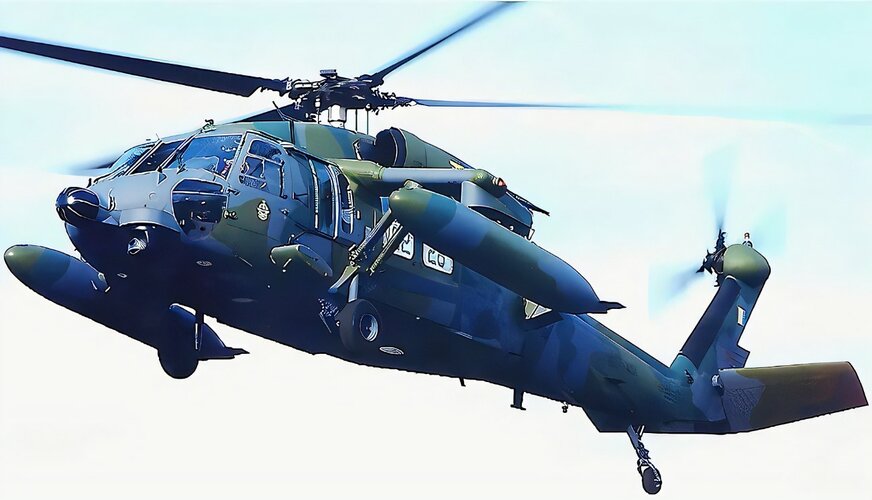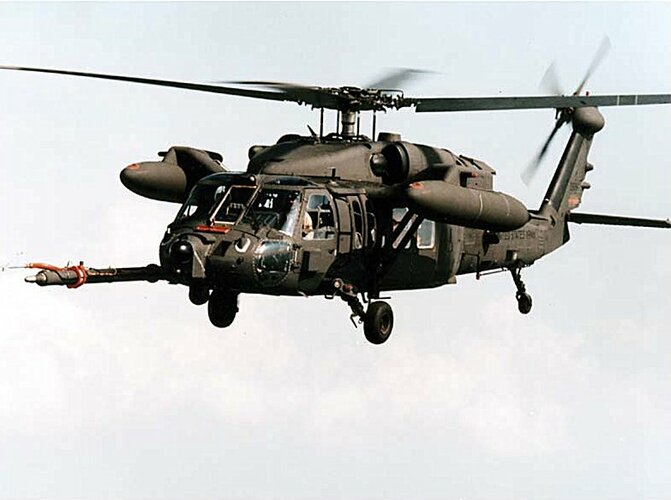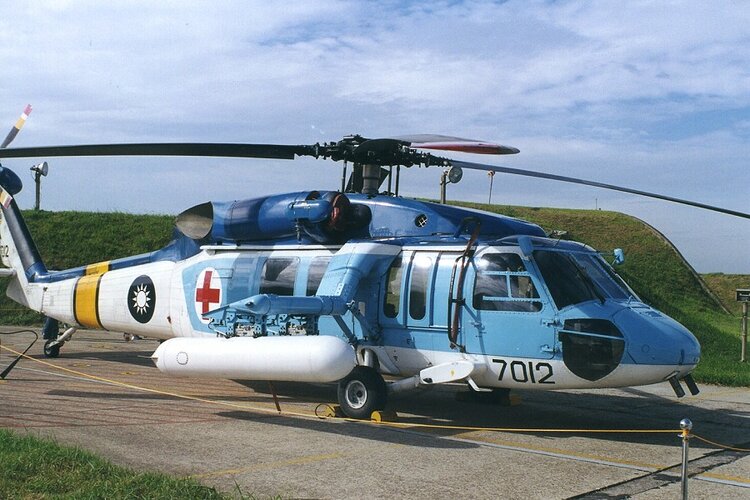You are using an out of date browser. It may not display this or other websites correctly.
You should upgrade or use an alternative browser.
You should upgrade or use an alternative browser.
The ESSS and something of Blackhawk
- Thread starter Blueking
- Start date
Colonial-Marine
UAVs are now friend, drones are the real enemy.
- Joined
- 5 October 2009
- Messages
- 1,474
- Reaction score
- 1,327
Are you sure that 3rd one isn't the same as the first just without the inner pylons fitted? It might just look shorter because of perspective.
I'm not certain for the reason behind the newer design that angles down before straightening out again. No idea if it's intended to replace the old ESSS out just supplement it for certain Blackhawks variants.
I'm not certain for the reason behind the newer design that angles down before straightening out again. No idea if it's intended to replace the old ESSS out just supplement it for certain Blackhawks variants.
Scott Kenny
ACCESS: USAP
- Joined
- 15 May 2023
- Messages
- 11,663
- Reaction score
- 14,364
There's also the unique ESSS that the Japanese use, where the outer ends of the pylons are actually raised.

I'm surprised that the USAF hasn't adopted this version for their Pave Hawks, as it gets the fuel tanks out of the line of fire of the door guns.
I'm surprised that the USAF hasn't adopted this version for their Pave Hawks, as it gets the fuel tanks out of the line of fire of the door guns.
Kat Tsun
eeeeeeeeeeeeeee
- Joined
- 16 June 2013
- Messages
- 1,371
- Reaction score
- 1,778
Because the American wings have an additional pair of wetted pylons:

The USAF also learned that door guns are worthless in Vietnam. They got HH-3s killed more often than not. Primary survival concerns for CSAR ships is time in fire zone and that's directly related to the sprint speed, hover time needed, and door guns. Escort aircraft are generally more effective for suppression.
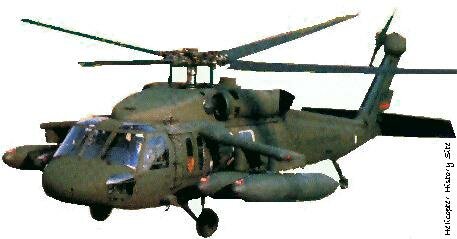
The USAF also learned that door guns are worthless in Vietnam. They got HH-3s killed more often than not. Primary survival concerns for CSAR ships is time in fire zone and that's directly related to the sprint speed, hover time needed, and door guns. Escort aircraft are generally more effective for suppression.
- Joined
- 11 March 2012
- Messages
- 3,250
- Reaction score
- 3,179
The drooped and strut-braced stub wings can be built much lighter.
There is also the question of what is the ideal height for ground-crew gravity-refuelling drop tanks.
Similarly, ground crew trying to rapidly re-load guns of missiles - on stub wings - want those missile-launchers at the ideal height for quick re-loading. The less ground support equipment needed, the quicker you can re-load. IOW the last thing ground crew want to worry about is transporting a fork-lift to a remote re-arming point.
- Joined
- 11 March 2012
- Messages
- 3,250
- Reaction score
- 3,179
Ah!I have found 3 type stub wing for H-60 helicopter。
This is the first one , it's outer panel could be removed
View attachment 711835
View attachment 711836
The age-old problem of how to cram all the variable/consumable/expendable weights as close as possible to the center-of-gravity.
Ah!
In this case, they try to spread the variable load side-ways/span-wise. A great idea until an outboard fuel tank refuses to feed and you develop a lateral imbalance.
Kiltonge
Greetings Earthling
- Joined
- 24 January 2013
- Messages
- 636
- Reaction score
- 1,195
The USAF also learned that door guns are worthless in Vietnam. They got HH-3s killed more often than not. Primary survival concerns for CSAR ships is time in fire zone and that's directly related to the sprint speed, hover time needed, and door guns. Escort aircraft are generally more effective for suppression.
Odd statement as every USAF CSAR helicopter has been fitted with door guns right up to the HH-60W just entering service.
In fact they are supplementing the forward M134s with twin M240s aft..
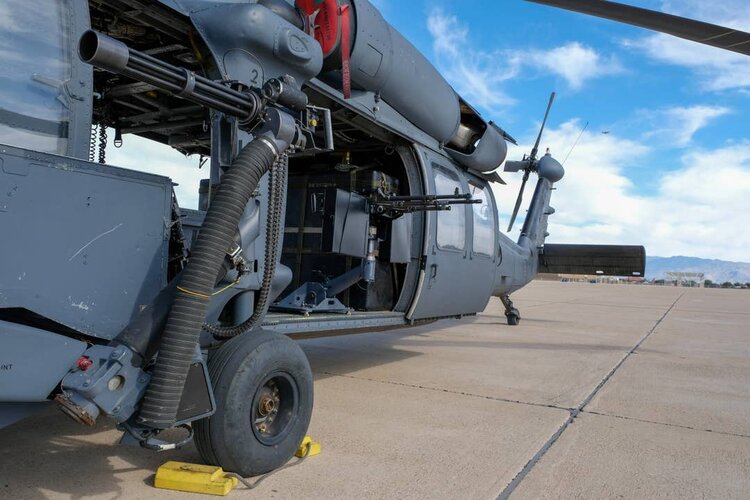
Kat Tsun
eeeeeeeeeeeeeee
- Joined
- 16 June 2013
- Messages
- 1,371
- Reaction score
- 1,778
Odd statement as every USAF CSAR helicopter has been fitted with door guns right up to the HH-60W just entering service.
In fact they are supplementing the forward M134s with twin M240s aft..
View attachment 712566
Sorry, by "door gun" I should have specified "manually targeted, unstabilized mount with a range less than 2,000 meters".
The little door guns make sense when you intend to fight only guys armed with 5.45mm to 7.62mm AK rifles, like in Afghanistan. They don't make much sense when you have to fight guys with QW-2s and 30mm-armed ZBDs (or 9K333s and 30-57mm armed BMPs), or even when you have to fight guys with 12.7mms and 14.5mms like in Vietnam.
Back when CSAR had common sense:
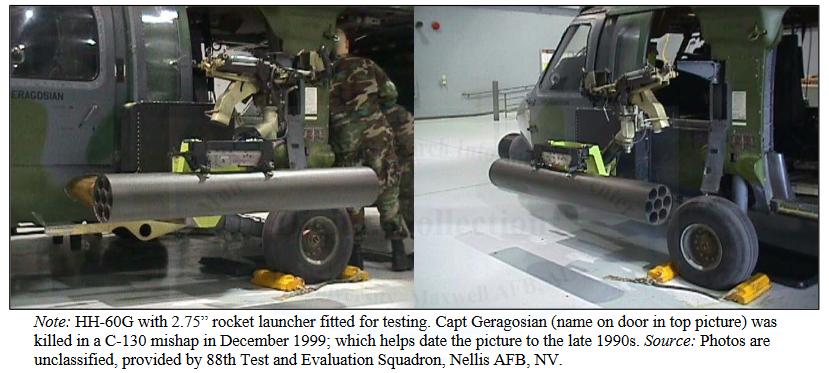
Give the little machine gun a stabilized bracket and a big FLIR like a Protector RWS and it would be good. V-22 has something similar on its belly, but V-22 has too much downwash to be a serious CSAR aircraft (and no stub wings but they could probably be fitted), whereas H-60 is just too small and wimpy to be a serious one. Neither are particularly good for different reasons.
A more reasonable solution would be an unarmed rescue ship, and a pair of gunships, something like the MH-60 DAP. MACV(SOG) did something like that in SEA (2:1 ratio of gunships:slicks) and it worked out really well in lieu of fixed-wing attack aircraft. CSAR might be able to muster fewer sorties, and require training more in light attack missions rather than recovery, but it would probably be more practical given the -60W's shortcomings.
Last edited:
- Joined
- 16 April 2008
- Messages
- 9,608
- Reaction score
- 14,508
Sorry, by "door gun" I should have specified "manually targeted, unstabilized mount with a range less than 2,000 meters".
The little door guns make sense when you intend to fight only guys armed with 5.45mm to 7.62mm AK rifles. These weren't humongous killers of aircraft in Vietnam, so no reason to think it'd be different in Afghanistan, without 12.7mm or 14.5mm backing them up. They don't make much sense when you have to fight guys with QW-2s and 30mm-armed ZBDs (or 9K333s and 30-57mm armed BMPs), though.
Back when CSAR had common sense:
View attachment 712588
Give the little machine gun a stabilized bracket and a big FLIR like a Protector RWS and it would be good. You'd need a console to operate it, but it would be able to hit people all around the aircraft because it's not literally in the window, and it'd be more lethal since it can see at night.
Something like the Battlehawk 20mm turret under the cabin, perhaps. Without the ESSS and such to weigh it down and possibly interfere with the rescue hoist.
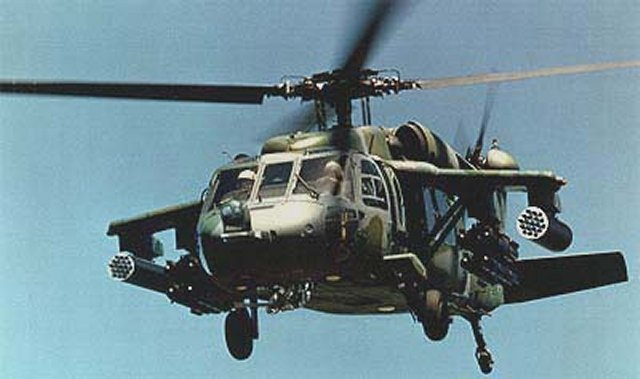
- Joined
- 18 October 2006
- Messages
- 4,211
- Reaction score
- 4,921
There is a reason why the "suppression" weapons on U.S. Army assault helicopters, are restricted to squad automatic weapons; weight and cube (note they huge external ammo box in the picture above). Large(r) amounts of ammunition, in the case of the 7.62 mini-gun, or something as heavy as a 20mm ( which would dictate strengthening the mounting points [more weight]) add much larger space and weight requirements. Heavier weapons on Special Operations Helicopters are acceptable because they are not expecting to fill the cargo compartment full of troops, just a few SOF soldiers, They can afford larger ammunition boxes. Also as they tend to operate in smaller numbers where volume of fire is not as great.Sorry, by "door gun" I should have specified "manually targeted, unstabilized mount with a range less than 2,000 meters".
The little door guns make sense when you intend to fight only guys armed with 5.45mm to 7.62mm AK rifles. They don't make much sense when you have to fight guys with QW-2s and 9K333s, though. So which war is CSAR planning to fight?
Back when CSAR had common sense:
View attachment 712588
Now just get rid of the wimpy lil M240 and replace it with a 20mm M197 or something and it'd be okay. You'd match 14.5mm at least and have an explosive payload that would actually keep people's heads down. That said the fact that the USAF still uses the HH-60 for CSAR, instead of funding further development of something like the X-49 Speedhawk, says a lot about what the USAF writ large thinks of CSAR.
Another reason that most NATO assault helicopters do not have larger suppression weapons was that the Conventional Forces Europe Treaty defined squad automatic weapons as the largest weapon on helicopters without redefining them.
Edit: I was a proponent for the Battlehawk, until I learned that the amount of modifications turned it into an attack helicopter. It was not as simple as "dropping the wings" to turn it into a troop ship. All of the black boxes for the sensors and the ammunition box for the cannon consumed the floor of the cargo compartment. Still having a single platform for both lift and attack would likely serve some countries very well. Even if they were discreet platforms.
Last edited:
Kat Tsun
eeeeeeeeeeeeeee
- Joined
- 16 June 2013
- Messages
- 1,371
- Reaction score
- 1,778
Something like the Battlehawk 20mm turret under the cabin, perhaps. Without the ESSS and such to weigh it down and possibly interfere with the rescue hoist.
View attachment 712589
20mm is just Soviet brain coming out. Americans use the .50 cal ball belt where Soviets used 23mm HEI belt. Neither will hit the roughly 7 to 8 kilometer standoff demands a FIM-92 or 9K38 places on the recovery aircraft, anyway, and stuff like door guns are for shooting at guys with AK-74s or PKMs generally.
There's a paper by a MAJ B.T. Losacker on DTIC that talks about the issue of CSAR in a "big war" (to a degree). It's where the picture of the external rocket pod-machine gun comes from. He mentions training CSAR troops in light attack missions, as it's already implied in the recovery phase anyway, and assigning a ratio of 2:1 gunships:slicks like the MACV(SOG) could work well given the overlap of SOF insertion and CSAR mission during the terminal phases. He also estimates that two major regional wars would drain the entire CSAR inventory, and suggests a fleet size of 200 ships would be able to cover that instead of the 112 HH-60W buy.
It seems like CSAR's problems mostly come from the lack of suitable aircraft between H-60 and H-53, and the fact that it keeps regressing to lessons hovering (ha) between the early-war and late-war Vietnam conflict, while never quite making the jump to CASA-like super jet planes or whatever. That's understandable, it was the last time the USAF fought a challenging air defense environment, and had to make CSAR a priority for theater combat operations, so there's no real impetus to change what works without seeing it not work.
I'm not sure there's a real good solution at the moment, because HH-60 is so short legged and V-22 is so bad at hovering, but MAJ Losacker really likes the X-49 for some reason. It doesn't really solve the problems of HH-60 being a tiny aircraft, makes hover performance marginally worse, but at least it's fast and won't crush you with rotor wash like a V-22, I guess?
There is a reason why the "suppression" weapons on U.S. Army assault helicopters, are restricted to squad automatic weapons; weight and cube (note they huge external ammo box in the picture above). Large(r) amounts of ammunition, in the case of the 7.62 mini-gun, or something as heavy as a 20mm ( which would dictate strengthening the mounting points [more weight]) add much larger space and weight requirements. Heavier weapons on Special Operations Helicopters are acceptable because they are not expecting to fill the cargo compartment full of troops, just a few SOF soldiers, They can afford larger ammunition boxes. Also as they tend to operate in smaller numbers where volume of fire is not as great.
Another reason that most NATO assault helicopters do not have larger suppression weapons was that the Conventional Forces Europe Treaty defined squad automatic weapons as the largest weapon on helicopters without redefining them.
Edit: I was a proponent for the Battlehawk, until I learned that the amount of modifications turned it into an attack helicopter. It was not as simple as "dropping the wings" to turn it into a troop ship. All of the black boxes for the sensors and the ammunition box for the cannon consumed the floor of the cargo compartment. Still having a single platform for both lift and attack would likely serve some countries very well. Even if they were discreet platforms.
Ironically it seems something like Mi-24, a gunship with limited troop carrying capability, would be better for CSAR as the USAF does it. Maybe it's the only way to do CSAR in a seriously big war, where 30mm-armed BMPs and MANPADS are in every platoon, who knows.
Last edited:
- Joined
- 3 January 2006
- Messages
- 1,223
- Reaction score
- 944
There was no room for a rescue diver, hoist operator and hoist in a Hind or the abortive American equivalent, the Sikorsky S-67.20mm is just Soviet brain coming out. Americans use the .50 cal ball belt where Soviets used 23mm HEI belt. Neither will hit the roughly 7 to 8 kilometer standoff demands a FIM-92 or 9K38 places on the recovery aircraft, anyway, and stuff like door guns are for shooting at guys with AK-74s or PKMs generally.
There's a paper by a MAJ B.T. Losacker on DTIC that talks about the issue of CSAR in a "big war" (to a degree). It's where the picture of the external rocket pod-machine gun comes from. He mentions training CSAR troops in light attack missions, as it's already implied in the recovery phase anyway, and assigning a ratio of 2:1 gunships:slicks like the MACV(SOG) could work well given the overlap of SOF insertion and CSAR mission during the terminal phases. He also estimates that two major regional wars would drain the entire CSAR inventory, and suggests a fleet size of 200 ships would be able to cover that instead of the 112 HH-60W buy.
It seems like CSAR's problems mostly come from the lack of suitable aircraft between H-60 and H-53, and the fact that it keeps regressing to lessons hovering (ha) between the early-war and late-war Vietnam conflict, while never quite making the jump to CASA-like super jet planes or whatever. That's understandable, it was the last time the USAF fought a challenging air defense environment, and had to make CSAR a priority for theater combat operations, so there's no real impetus to change what works without seeing it not work.
I'm not sure there's a real good solution at the moment, because HH-60 is so short legged and V-22 is so bad at hovering, but MAJ Losacker really likes the X-49 for some reason. It doesn't really solve the problems of HH-60 being a tiny aircraft, makes hover performance marginally worse, but at least it's fast and won't crush you with rotor wash like a V-22, I guess?
Ironically it seems something like Mi-24, a gunship with limited troop carrying capability, would be better for CSAR as the USAF does it. Maybe it's the only way to do CSAR in a seriously big war, where 30mm-armed BMPs and MANPADS are in every platoon, who knows.
- Joined
- 18 October 2006
- Messages
- 4,211
- Reaction score
- 4,921
I would agree with @Kat Tsun that a platform that is heavily armed/armored with sufficient space for the necessary personnel mentioned by @TinWing would be the optimal solution. I would also note that "speed" is an important factor, especially as many missions will take place over extended distances. I recall, but cannot quote, a study that indicated that time is of critical importance in the conduct of CSAR as the stranded personnel are closed in on.
If memory serves an F-15 crew was recovered by USMC MV-22 TRAP in Libya {?] before the USAF could even start to get a CSAR mission in position to execute a recovery.
Blackhawk is a brilliant aircraft and will continue to serve over the 21st Century around the world, but it is, no matter how much fuel and propulsion you put on it will it be able to meet the expected demands for the CSAR mission. SAR it clearly does a more than satisfactory job.
If memory serves an F-15 crew was recovered by USMC MV-22 TRAP in Libya {?] before the USAF could even start to get a CSAR mission in position to execute a recovery.
Blackhawk is a brilliant aircraft and will continue to serve over the 21st Century around the world, but it is, no matter how much fuel and propulsion you put on it will it be able to meet the expected demands for the CSAR mission. SAR it clearly does a more than satisfactory job.
Last edited:
Similar threads
-
The Unbuilt Helicopter Projects of Hans Berger
- Started by hesham
- Replies: 13
-
A project for 12/12/12 - the BAe P.1212-12!
- Started by Mike Pryce
- Replies: 5
-
-
-

